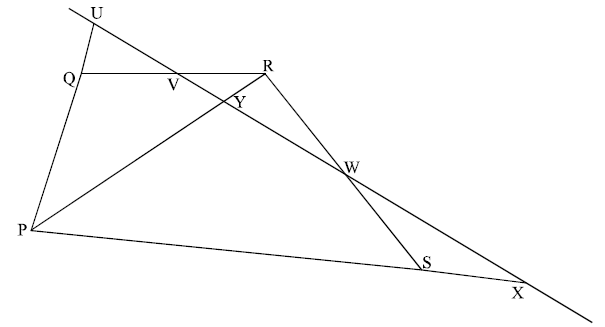| Date | May 2008 | Marks available | 7 | Reference code | 08M.2.hl.TZ0.3 |
| Level | HL only | Paper | 2 | Time zone | TZ0 |
| Command term | Show that | Question number | 3 | Adapted from | N/A |
Question

The diagram shows the line \(l\) meeting the sides of the triangle ABC at the points D, E and F. The perpendiculars to \(l\) from A, B and C meet \(l\) at G, H and I.
(i) State why \(\frac{{{\rm{AF}}}}{{{\rm{FB}}}} = \frac{{{\rm{AG}}}}{{{\rm{HB}}}}\) .
(ii) Hence prove Menelaus’ theorem for the triangle ABC.
(iii) State and prove the converse of Menelaus’ theorem.
A straight line meets the sides (PQ), (QR), (RS), (SP) of a quadrilateral PQRS at the points U, V, W, X respectively. Use Menelaus’ theorem to show that\[\frac{{{\rm{PU}}}}{{{\rm{UQ}}}} \times \frac{{{\rm{QV}}}}{{{\rm{VR}}}} \times \frac{{{\rm{RW}}}}{{{\rm{WS}}}} \times \frac{{{\rm{SX}}}}{{{\rm{XP}}}} = 1.\]
Markscheme
(i) Because the triangles AGF and BHF are similar. R1
(ii) It follows (by cyclic rotation or considering similar triangles) that
\(\frac{{{\rm{BD}}}}{{{\rm{DC}}}} = \frac{{{\rm{BH}}}}{{{\rm{IC}}}}\) A1
and \(\frac{{{\rm{CE}}}}{{{\rm{EA}}}} = \frac{{{\rm{CI}}}}{{{\rm{GA}}}}\) A1
Multiplying these three results gives Menelaus’ Theorem, i.e.
\(\frac{{{\rm{AF}}}}{{{\rm{FB}}}} \times \frac{{{\rm{BD}}}}{{{\rm{DC}}}} \times \frac{{{\rm{CE}}}}{{{\rm{EA}}}} = \frac{{{\rm{AG}}}}{{{\rm{HB}}}} \times \frac{{{\rm{BH}}}}{{{\rm{IC}}}} \times \frac{{{\rm{CI}}}}{{{\rm{GA}}}}\) M1A1
\( = \frac{{{\rm{AG}}}}{{{\rm{GA}}}} \times \frac{{{\rm{BH}}}}{{{\rm{HB}}}} \times \frac{{{\rm{CI}}}}{{{\rm{IC}}}} = - 1\) M1A1
(iii) The converse states that if D, E, F are points on the sides (BC), (CA), (AB) of a triangle such that
\(\frac{{{\rm{AF}}}}{{{\rm{FB}}}} \times \frac{{{\rm{BD}}}}{{{\rm{DC}}}} \times \frac{{{\rm{CE}}}}{{{\rm{EA}}}} = - 1\)
then D, E, F are collinear. A1
To prove this result, let D, E, F′ be collinear points on the three sides so that, using the above theorem, M1
\(\frac{{{\rm{AF'}}}}{{{\rm{F'B}}}} \times \frac{{{\rm{BD}}}}{{{\rm{DC}}}} \times \frac{{{\rm{CE}}}}{{{\rm{EA}}}} = - 1\) A1
Since \(\frac{{{\rm{AF}}}}{{{\rm{FB}}}} \times \frac{{{\rm{BD}}}}{{{\rm{DC}}}} \times \frac{{{\rm{CE}}}}{{{\rm{EA}}}} = - 1\) M1
\(\frac{{{\rm{AF'}}}}{{{\rm{F'B}}}} = \frac{{{\rm{AF}}}}{{{\rm{FB}}}}\) A1
and \({\rm{F = F'}}\) which proves the converse. R1
[13 marks]

Draw the diagonal PR and let it cut the line at the point Y. M1
Apply Menelaus’ Theorem to the triangle PQR. Then,
\(\frac{{{\rm{PU}}}}{{{\rm{UQ}}}} \times \frac{{{\rm{QV}}}}{{{\rm{VR}}}} \times \frac{{{\rm{RY}}}}{{{\rm{YP}}}} = - 1\) M1A1
Now apply the theorem to triangle PRS.
\(\frac{{{\rm{PY}}}}{{{\rm{YR}}}} \times \frac{{{\rm{RW}}}}{{{\rm{WS}}}} \times \frac{{{\rm{SX}}}}{{{\rm{XP}}}} = - 1\) A1
\(\frac{{{\rm{PU}}}}{{{\rm{UQ}}}} \times \frac{{{\rm{QV}}}}{{{\rm{VR}}}} \times \frac{{{\rm{RY}}}}{{{\rm{YP}}}} \times \frac{{{\rm{PY}}}}{{{\rm{YR}}}} \times \frac{{{\rm{RW}}}}{{{\rm{WS}}}} \times \frac{{{\rm{SX}}}}{{{\rm{XP}}}} = - 1 \times - 1\) M1
\( \Rightarrow \frac{{{\rm{PU}}}}{{{\rm{UQ}}}} \times \frac{{{\rm{QV}}}}{{{\rm{VR}}}} \times \frac{{{\rm{RW}}}}{{{\rm{WS}}}} \times \frac{{{\rm{SX}}}}{{{\rm{XP}}}} \times \frac{{{\rm{PY}}}}{{{\rm{YP}}}} \times \frac{{{\rm{RY}}}}{{{\rm{YR}}}} = 1\) A1
\( \Rightarrow \frac{{{\rm{PU}}}}{{{\rm{UQ}}}} \times \frac{{{\rm{QV}}}}{{{\rm{VR}}}} \times \frac{{{\rm{RW}}}}{{{\rm{WS}}}} \times \frac{{{\rm{SX}}}}{{{\rm{XP}}}} \times ( - 1) \times ( - 1) = 1\) (M1)
\( \Rightarrow \frac{{{\rm{PU}}}}{{{\rm{UQ}}}} \times \frac{{{\rm{QV}}}}{{{\rm{VR}}}} \times \frac{{{\rm{RW}}}}{{{\rm{WS}}}} \times \frac{{{\rm{SX}}}}{{{\rm{XP}}}} = 1\) AG
[7 marks]

